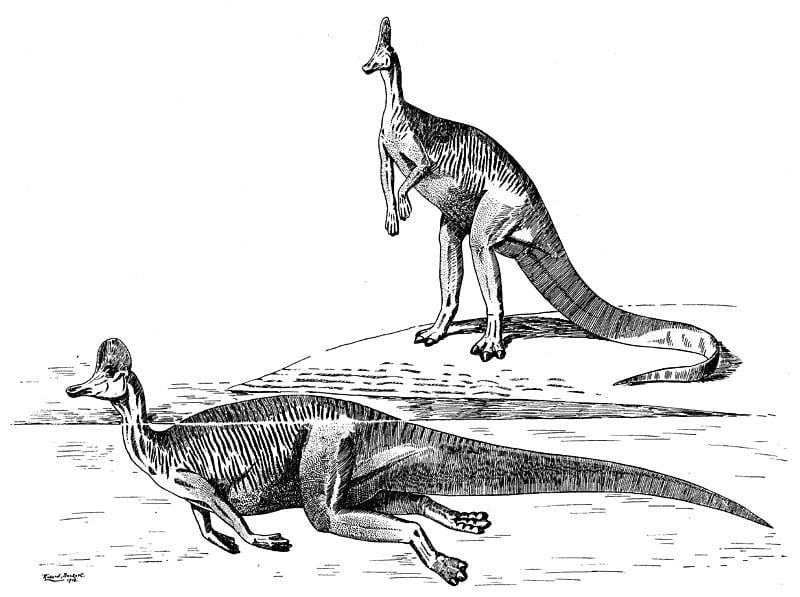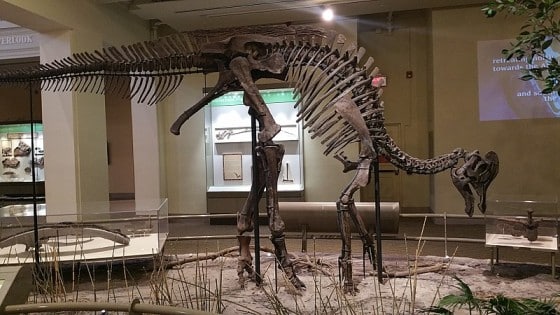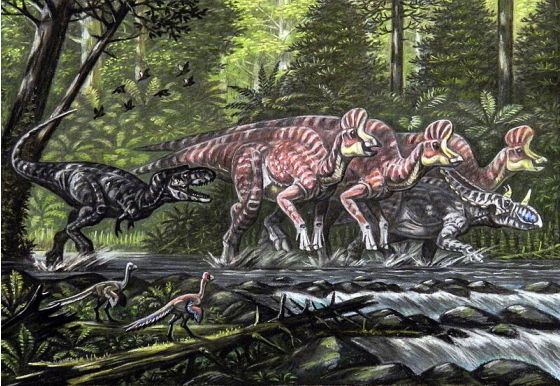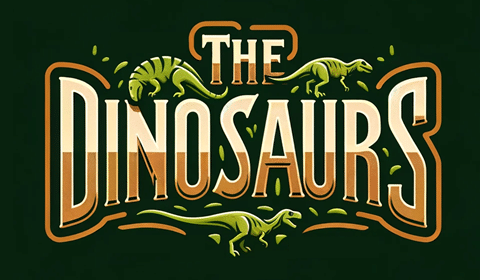Corythosaurus was a duck-billed dinosaur that roamed the Earth during the Late Cretaceous period, around 83-72 million years ago. Discovered first in Alberta, Canada in 1914, several specimens have been uncovered in later years.
The name of the dinosaur reflects the fascinataing crest it had on top of its head. Dive into its world below to learn more about its ecosystem, features and behavior.
Corythosaurus Key Facts
| Corythosaurus pronunciation | koh-RITH-oh-SAWR-us |
| Meaning of name | Corinthian Helmet lizard |
| Group | Ornithopod |
| Type Species | Corythosaurus casuarius |
| Diet | Herbivore |
| When it Lived | 83.5 to 72.1 MYA |
| Period | Late Cretaceous |
| Epoch | Campanian |
| Length | 33.0 ft |
| Height | 15.0 ft at hips |
| Weight | 4.0 to 5.0 tons |
| Mobility | Moved on two legs |
| First Discovery | 1912 by Barnum Brown |
| Location of first find | Alberta, Canada |
| First Described by | 1914 by Barnum Brown |
| Holotype | AMNH 5240 |
Corythosaurus Taxonomy and Timeline

Corythosaurus, aka the ‘helmet lizard’, gets its name from the Greek words ‘korythos’ meaning Corinthian, as in a Corinthian helmet and ‘sauros’ meaning lizard. This name is a nod to the dinosaur’s distinctive crest that resembles the helmets worn by ancient Greek warriors.
It belongs to the Ornithopoda, or ‘bird-footed’ dinosaurs–a group known for their bird-like stance and herbivorous diet. Within this group, Corythosaurus is a member of the Hadrosauridae family and specifically the Lambeosaurinae subfamily, characterized by their hollow crests.
The specific type species name‘ casuarius‘ is a nod to the Cassowary bird, living today, which has a similar imposing crest.
Corythosaurus lived during the Late Cretaceous period. This was a time when dinosaurs were the dominant terrestrial vertebrates, and the Earth was warm and tropical. The Late Cretaceous period was also the last chapter of the Mesozoic Era, often referred to as the ‘Age of Dinosaurs’.
Listen to Pronunciation
Fossils Discovery
The first fossil was found in the Red Deer River region of Alberta, Canada–a location known for its rich dinosaur fossil record. This initial discovery was made by renowned American paleontologist Barnum Brown in 1912.
Subsequently numerous other Corythosaurus fossils have been unearthed in the region as well as one specimen found south of the border, in Montana, USA. These fossils include a variety of specimens, from nearly complete skeletons to isolated bones that all provide a comprehensive view of the dinosaur’s anatomy.
These additional finds have further expanded our understanding of C. casuarius and provided a broader picture of its geographical range during the Late Cretaceous period.

Many of the fossils are particularly well-preserved, with some specimens even retaining impressions of the dinosaur’s skin. This level of preservation has allowed paleontologists to study the dinosaur’s physical characteristics in detail and reveal insights about its lifestyle and behavior.
Corythosaurus Size and Description
C. casuarius was a large dinosaur characterized by its distinctive crest and bird-like stance. Its body is streamlined with a long, slender neck and a tail that balances its body when it moves. The dinosaur’s head was adorned with a hollow, helmet-like crest that is believed to have played a role in communication and possibly thermoregulation. Its limbs were robust, with the hind limbs being longer than the forelimbs, suggesting that it was primarily bipedal. The dinosaur’s skin is believed to have been covered in scales similar to modern reptiles.
Size and Weight of Type Species

Corythosaurus is a large dinosaur, with estimates suggesting a length somewhere between 26 and 33 feet, and a height of around 15 feet at the hips. However, these estimates can vary based on the individual specimen and the method used for the calculation. The weight is harder to determine but it’s generally believed to have weighed around 4-5 tons US tons. These estimates give us a glimpse of the impressive size of this dinosaur and highlight its stature among the fauna of the Late Cretaceous period.
The Dinosaur in Detail
Corythosaurus is a remarkable dinosaur, not just for its size but also for its unique features and adaptations. One of the most distinctive features of the Corythosaurus is its helmet-like crest. This crest is hollow and connected to the nasal passages which suggests that it may have been used for communication, possibly producing low-frequency sounds. This feature sets it apart from many other dinosaurs and reflects its adaptability and survival instincts.
Another notable aspect of this dinosaur is its teeth. It had a dental battery consisting of hundreds of tightly packed teeth that were continually replaced as they wore out. This adaptation allowed it to efficiently process its herbivorous diet, which likely included a variety of plants prevalent during the Late Cretaceous period.
It also exhibits a degree of sexual dimorphism, with males believed to have larger and more elaborate crests than females. This suggests that, like many modern animals, the Corythosaurus may have used visual signals in mate selection–further highlighting the complexity of its behavior and social structure.
The Corythosaurus in its Natural Habitat

This herbivore lived in a world vastly different from our own. North America in the Cretaceous was separated into two paleocontinents–Laramidia to the west and Appalachia to the east. As a Laramidian dinosaur, Corythosaurus inhabited a world that was warm and tropical, with lush vegetation and diverse fauna. It is likely that it had a diet rich in fibrous vegetation due to continually wearing down and replacing hundreds of tightly packed teeth. This process would have allowed it to process large amounts of tough vegetation.
Corythosaurus was primarily bipedal and moved on its hind limbs. This mode of locomotion, combined with its size and potential speed, may have played a role in its interactions with other dinosaurs by possibly influencing its predator-prey relationships. As an herbivorous dinosaur, it likely played a significant role in shaping the vegetation of its environment and contributing to the ecosystem dynamics of the Late Cretaceous period.
Its social behavior is not well understood but some evidence suggests that it may have been a herd animal. This behavior could have had implications for its life expectancy, with herd living potentially offering protection from predators. The dinosaur’s distinctive crest may have also played a role in its social interactions by possibly being used for communication within the herd. All these factors paint a picture of a dinosaur that was well adapted to its environment and played a significant role in the ecosystems of the Late Cretaceous period.
Interesting Points about Corythosaurus
- It is known for its distinctive crest that may have been used for communication and possibly thermoregulation.
- The dinosaur’s teeth were continually replaced as they wore out, which allowed it to efficiently process its herbivorous diet.
- It exhibits a degree of sexual dimorphism with males having larger and more elaborate crests than females.
- The dinosaur’s fossils are particularly well-preserved and some specimens even retained impressions of the skin.
- In addition to the initial find in Alberta, more Corythosaurus fossils have been discovered in Alberta, Canada and in Montana, United States.
Contemporary Dinosaurs
Corythosaurus shared its environment with an interesting group of contemporary dinosaurs. Among these were the Parasaurolophus, Tyrannosaurus, Triceratops, and Ankylosaurus. Each of these dinosaurs contributed to the intricate dynamics of the Late Cretaceous in western North America.
Parasaurolophus was a fellow herbivore and similar in many ways to Corythosaurus. Both adorned with impressive crests, they likely grazed side by side and painted a serene picture of prehistoric life with their harmonious coexistence. Beneath this tranquility, a subtle competition may have existed through a silent contest for the most lush and nutritious vegetation.
On the other hand, Triceratops and Ankylosaurus were both heavily armored and represent the other end of the spectrum. Despite their diversities, it’s likely these dinosaurs would have occupied the same niche and provided more competition for Corythosaurus. These herbivores, with their formidable defenses, would have been a challenging target even for the mightiest of predators at the time.
Enter Tyrannosaurus Rex –a stark contrast to Corythosaurus. This colossal carnivore’s formidable size and fearsome reputation might have posed a significant threat. Corythosaurus would have been dwarfed by this apex predator. This potential predator-prey relationship adds a layer of tension and drama to the narrative of their coexistence.Their presence in the same environment suggests a landscape punctuated by moments of intense confrontation, further emphasizing Corythosaurus’s need for vigilance and agility in this diverse and dynamic ecosystem.
List of All Dinosaurs
We have created a list of all dinosaurs we have covered here, sorted across the seven main groups of dinosaurs. We also include information about their type of diet, (omnivore, herbivore or carnivore) and the time they lived.
Frequently Asked Questions
The name translates to ‘helmet lizard’, a nod to its distinctive crest that resembles a helmet.
It lived during the Late Cretaceous period in western North America.
This was a herbivore that fed on a variety of plants prevalent during the Late Cretaceous period. It is likely that its diet focused on tough, fibrous vegetation.
Fossils have been found in Alberta, Canada and Montana, United States so far.
It is known for its distinctive crest, which is believed to have been used for communication and possibly thermoregulation. It also had a dental battery consisting of hundreds of tightly packed teeth that allowed it to efficiently process its herbivorous diet.
This was a large dinosaur, with estimates suggesting a length of about 33 feet and a height of around 15 feet at the hips. It’s generally believed to have weighed around 4-5 tons.
Sources
- https://www.tandfonline.com/doi/abs/10.1080/02724634.2021.1878202?journalCode=ujvp20
- https://www.researchgate.net/publication/343445291_The_unusual_tail_of_tethyshadros_insularis_Dinosauria_Hadrosauroidea_from_the_adriatic_island_of_the_european_archipelago
- https://www.nature.com/articles/s41598-019-41325-8
- https://www.tandfonline.com/doi/abs/10.1080/14772019.2013.770417
- https://www.sciencedirect.com/science/article/abs/pii/S0195667111001960
This article was last fact checked:Joey Arboleda, 06-11-2023
Featured Image Credit: Richard Beckert, Public domain, via Wikimedia Commons
